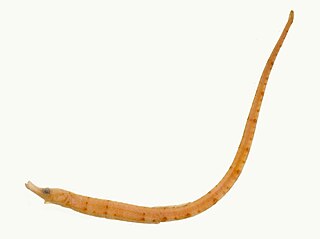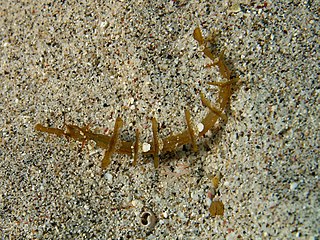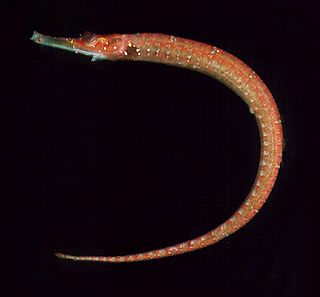Microphis lineatus, the opossum pipefish, is a species of fish in the family Syngnathidae. It is found in fresh, brackish and marine waters in the West Atlantic region, ranging from New Jersey, United States, to São Paulo, Brazil, including the Caribbean and Gulf of Mexico. It is often found in rivers, among water hyacinth roots, in mangrove and in Sargassum.

The ribboned pipefish, ribboned pipehorse or ribboned seadragon, is a species of pipefish found along the coast of northern Australia and New Guinea in habitats ranging from shallow and weedy to deeper and sandy bottoms down to depths of 16.5 m (54 ft). This species grows to a total length of 30 cm (12 in). Their colors can range from greenish yellow to brownish red. This species is the only known member of its genus.

The trawl pipefish, Kimblaeus bassensis, is a species of pipefish found only in the Tasman Sea and the Bass Strait off of the southern coast of Australia, where it can be found at depths from 58 to 74 m. This species grows to 16 cm (6.3 in) in standard length. This species is the only known member of its genus.

Halicampus macrorhynchus or also commonly known as the ornate pipefish , whiskered pipefish or winged pipefish is a species of fish in the family Syngnathidae.
Cosmocampus albirostris is a marine fish of the family Syngnathidae. It is found in the western Atlantic Ocean, along the US coast from North Carolina to Florida, in the Gulf of Mexico, along the Yucatán Peninsula to Cuba, in the Caribbean from Puerto Rico to Grenada, and along Central and South America to southern Brazil. It lives among coral reefs, sea floor rubble, and sparse algae to depths of about 40 metres (130 ft), where it can grow to lengths of 20 centimetres (7.9 in). This species is ovoviviparous, with males carrying eggs in a brood pouch and giving birth to live young The Cosmocampus albirostris is a species of pipefish that has been historically collected in the State of Bahia. These species are in the Brazilian list of marine fishes that are authorized to be exported for ornamental purposes. This information was taken from a case study that monitored the ornamental trade of seahorses and pipefishes in Brazil, where harvesting of pipefish is common, and it was also discovered that Cosmocampus albirostris are predominantly harvested in reef areas.
Cosmocampus arctus is a species of marine fish of the family Syngnathidae. It is found from Tomales Bay, California, to Mazatlan, Mexico, and throughout the Gulf of California. It lives on rocky or coral reefs, among eelgrass and other seaweeds, and among algae. It inhabits depths to 10m, where it can grow to lengths of 12 cm. This species is ovoviviparous, with males carrying eggs in a brood pouch before giving birth to live young. Monogamous mating has also been observed in this species.
Cosmocampus balli is a species of fish of the family Syngnathidae. It is endemic to Hawaii, with observations off Oahu and Kauai. It lives is shallow, protected coral reef or rocky habitats, where it can grow to lengths of 7 centimetres (2.8 in). Although little is known about its feeding habits, it is expected to consume small crustaceans, similar to other pipefishes. This species is ovoviviparous, with males carrying eggs and giving birth to live young. Males can brood at 4.5 centimetres (1.8 in). The specific name honours the American zoologist Stanley Crittenden Ball (1885-1956) in acknowledgement of his "interest in the fishes of Oceania".
Cosmocampus banneri is a species of marine fish of the family Syngnathidae. It is found from the Red Sea and Western Indian Ocean to Fiji, the Marshall Islands, and the Ryukyu Islands. It lives in coral reefs at depths of 2-30m, where it can grow to lengths of 5.8 cm. Although little is known about the feeding habits of C. banneri, it is expected to feed on small crustaceans similar to other pipefish. This species is ovoviviparous, with males carrying eggs in a brood pouch until giving birth to live young. The specific name honours Albert Henry Banner (1914-1985), an American carcinologist who was an expert in alpheid shrimps.
Cosmocampus brachycephalus is a species of marine fish of the family Syngnathidae. It is found in the western Atlantic Ocean, near southern Florida (USA), the Bahamas, and northern South America. It lives in sub-tidal grass flats to depths of 10 metres (33 ft), where it can grow to lengths of 10 centimetres (3.9 in). This species ovoviviparous, with males carrying eggs and giving birth to live young.
Cosmocampus darrosanus is a species of marine fish of the family Syngnathidae. It is found in the Western Indian Ocean, Sri Lanka, Indonesia, Guam, and the Great Barrier Reef (Australia). It lives in tidepools and coral reefs to depths of 3 metres (9.8 ft), where it can grow to lengths of 7.4 centimetres (2.9 in). This species is ovoviviparous, with males carrying eggs before giving birth to live young. The specific name is taken from the type locality of D'Arros Island in the Amirante Islands.
Cosmocampus heraldi is a species of marine fish of the family Syngnathidae. It is known from only seven specimens, which were found at the Desventuradas and Juan Fernandez Islands in Chile. It inhabits rocky reefs and sandy areas at depths of 6–23 metres (20–75 ft), where it can grow to lengths of 7 centimetres (2.8 in). It is expected to feed on small crustaceans like other pipefish. This species is ovoviviparous, with males carrying eggs until giving birth to live young. The specific name honours the ichthyologist Earl Stannard Herald (1914-1973) who had a lifelong interest in pipefish.
Cosmocampus hildebrandi is a species of marine fish of the family Syngnathidae. It is found in the western Atlantic Ocean, off of the US coast from North Carolina south to the Gulf of Mexico, off the Yucatan Peninsula (Mexico), and off of northwestern Cuba. It inhabits sandy habitats with seagrass, coral, and rock substrates at depths of 5–75 metres (16–246 ft), where it can grow to lengths of 8.6 centimetres (3.4 in). This species is ovoviviparous, with males carrying eggs and giving birth to live young. The specific name honours the ichthyologist Samuel F. Hildebrand (1883-1949), who first recognised the holotype as being possibly a new species.
Cosmocampus howensis is a species of marine fish of the family Syngnathidae. It is found in the South Pacific from Jervis Bay to Easter Island. It lives in lagoons and on rocky reefs, where it grows to lengths of 10–12 centimetres (3.9–4.7 in). It is expected to feed on small crustaceans, similar to other pipefishes. This species is ovoviviparous, with males carrying eggs before giving birth to live young.
Cosmocampus investigatoris is a species of marine fish of the family Syngnathidae. It is found in the Indo-West Pacific, from the Persian Gulf to the Gulf of Thailand. It lives over sand, mud, and coral bottoms to depths of 15m, where it can grow to lengths of 9 cm. This species is ovoviviparous, with males carrying eggs in a brood pouch until giving birth to live young.

Cosmocampus maxweberi is a species of marine fish of the family Syngnathidae. It is found in the Red Sea from Sumatra to Tonga and Samoa, and from the Marshall Islands to the Great Barrier Reef. Adults live in reefs and reef-rubble to depths of 36 m, while planktonic juveniles have been found in the top 85m of 1500–2000 m water columns. Adults are expected to feed on small crustaceans, similar to other pipefish, and can grow to lengths of 10 cm. This species is ovoviviparous, with males carrying eggs until giving birth to live young. The specific name honours the German-Dutch zoologist and biogeographer Max Carl Wilhelm Weber (1852-1937).
Cosmocampus profundus is a species of marine fish of the family Syngnathidae. It is found near the southeastern US, the Virgin Islands, and the Yucatan Peninsula of Mexico. The few specimens of this species that have been collected were found over sand and coral at depths of 100-265m. This species is ovoviviparous, with males carrying eggs before giving birth to live young.
Cosmocampus retropinnis is a species of marine fish of the family Syngnathidae. The name retropinnis comes from the location of the species' dorsal fin as either caudal or posterior. The coloration of this organism is mostly brown and tan markings on its snout side, head's dorsum, side of the trunk, and venter of the tail. It is only known from a few juvenile specimens collected off southern Morocco and Gambia at depths to 79m. Little is known about its feeding habits, but it is expected to feed on small crustaceans, similar to other pipefish. This species is ovoviviparous, with males carrying eggs before giving birth to live young.
Festucalex cinctus is a species of marine fish of the pipefish family Syngnathidae which is endemic to the waters off eastern Australia.
Wass's pipefish is a species of marine fish of the family Syngnathidae. It is known from only six species, which were found in the coastal waters off Papua New Guinea, New Caledonia, Fiji, and Samoa. It inhabits soft coral habitats and coral rubble to depths of 50 metres (160 ft), where it can grow to lengths of 7.4 centimetres (2.9 in). Little is known of the species’ feeding habits, but it is expected to eat small crustaceans, similar to other pipefish. This species is ovoviviparous, with males carrying eggs and giving birth to live young. The specific name honours the U.S. Fish & Wildlife Service biologist Richard C. Wass.
Cosmocampus coccineus is a species of pipefish from the family Syngnathidae. It is found in the eastern Pacific Ocean from Bahía de Banderas in Mexico south to Bahía de la Independencia, southern Peru, and in waters off the Galapagos Islands. It is common among red algae and coral, down to depths of 18 metres (59 ft). It is an ovoviviparous breeder in which the male carries the eggs in a brood pouch which is located under his tail. C. coccineus has been regarded as a subspecies of C. arctus, along with C. heraldi.







